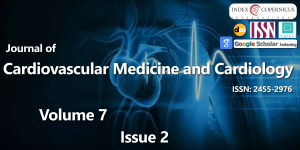Human umbilical cord blood derived mesenchymal cells for the treatment of myocardial infarction in rat model
Main Article Content
Abstract
Objectives: The present study was designed to know the possible protective and regenerative effects of human Umbilical Cord Blood (UCB) derived MSCs in Myocardia Infarction (MI) in rat model using Isoproterenol administration.
Material & methods: Isoproterenol injection was given subcutaneously for 2 days to induce MI in rat model. After development of MI various blood and tissue parameters were assessed sich as urea, creatinine, SGOT, SGPT, troponin I, Lactic Dehydrogenase (LDH) and Creatine Kinase (CK). Treatment was given by single dose of MSCs. After treatment period all the parameters were assessed again and comparison were done before and after treatment.
Results: After development of MI all the biochemical parameters were elevated. MSC transplantation, performed when MI have already developed, showed better results. It inhibits the degradation of normal collagen and the formation of poorly cross-linked collagens, resulting in attenuation of MI and improvement of heart function by means of troponin I, Lactic Dehydrogenase (LDH) and Creatine Kinase (CK) level. In addition, this impact is not instantaneous but is persistent for at least 90 days, supporting the role of MSC transplantation.
Conclusion: Our data suggested that transplantation of MSCs in MI model has improved the cardiac function. Till now, there is no evidence attributing this improvement to regeneration and other paracrine mechanisms are also believed to contribute in the improvement of cardiac function.
Downloads
Article Details
Copyright (c) 2020 Mehdi AG, et al.

This work is licensed under a Creative Commons Attribution 4.0 International License.
Jiang Y, Jahagirdar BN, Reinhardt RL, Schwartz RE, et al. (2002) Pluripotency of mesenchymal stem cells derived from adult marrow. Nature 418: 41-49. Link: https://bit.ly/355hQJ2
Caplan AI (2007) Adult mesenchymal stem cells for tissue engineering versus regenerative medicine. J Cell Physiol 213: 341-347. Link: https://bit.ly/2XZWsDE
Gluckman E, Ruggeri A, Volt F, Cunha R, Boudjedir K, et al. (2011) Milestones in umbilical cord blood transplantation. Br J Haematol 154: 441-447. Link: https://bit.ly/3cLGFfH
Finegold JA, Asaria P, Francis DP (2013) Mortality from ischaemic heart disease by country, region, and age: Statistics from World Health Organization and United Nations. Int J Cardiol 168: 934-945 Link: https://bit.ly/3axiBM8
Faiella W, Atoui R (2016) Therapeutic use of stem cells for cardiovascular disease. Clin Trans Med 5: 34 Link: https://bit.ly/2zxQ8ct
Thygesen K, Alpert JS, Jaffe AS, Simoons ML, Chaitman BR, et al. (2012) Third universal definition of myocardial infarction. Eur Heart J 33: 2551-2567 Link: https://bit.ly/3cPQ4mH
Eltyeb A, Tomasz S, Guarita-Souza LC, Teixeira de Carvalho KA, Gallo P, et al. (2011) Stem cell therapy in heart diseases: a review of selected new perspectives, practical considerations and clinical applications. Curr Cardiol Rev 7: 201-212 Link: https://bit.ly/3eMaGxQ
Mehdi AG, Ayapati VA, Choudry VS, Reddy VN, Surror AU, et al. (2018) Human Umbilical Cord Blood: A Potential Source for Mesenchymal Stem Cells. Int J Sci Res 7: 641-644.
Benjamin EJ, Virani SS, Callaway CW, Chamberlain AM, Chang AR, et al. (2018) Heart Disease and Stroke Statistics-2018 Update: A Report From the American Heart Association. Circulation 137: e67-e492. Link: https://bit.ly/3cQL9Sb
Scarborough P, Bhatnagar P, Wickramasinghe K, Smolina K, et al. (2010) Coronary heart disease statistics 2010. In British Heart Foundation heart statistics publications. British Heart Foundation.
Lloyd-Jones D, Adams RJ, Brown TM, Carnethon M, Dai S, et al. (2010) 644 Heart disease and stroke statistics—2010 update: a report from the American 645 Heart Association. Circulation 121: e46-e215. Link: https://bit.ly/2yEYXR8
Acikel M, Buyukokuroglu M. E, Erdogan F, Aksoy H, Bozkurt E, et al. (2005) Protective effects of dantrolene against myocardial injury induced by isoproterenol in rats: biochemical and histological findings. Int J Cardiol 98: 389-394. Link: https://bit.ly/2S7LHLB
Sangeetha T, Quine SD (2008) Protective effect of S-allyl cysteine sulphoxide (alliin) on glycoproteins and hematology in isoproterenol induced myocardial infarction in male Wistar rats. J Appl Toxicol 28: 710-716. Link: https://bit.ly/2Y1jCJP
Burr ML, Holliday RM, Fehily AM, Whitehead PJ (1992) Hematological prognostic indices after myocardial infarction: evidence from the diet and reinfarction trial (DART). Eur Heart J 13: 166-170. Link: https://bit.ly/2xc1CS2
Friedman GD, Tekawa I, Grimm RH, Manolio T, Shannon SG, et al. (1990) The leucocyte count: correlates and relationship to coronary risk factors: the CARDIA study. Int J Epidemiol 19: 889-893. Link: https://bit.ly/3bClexH





